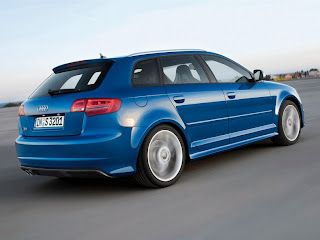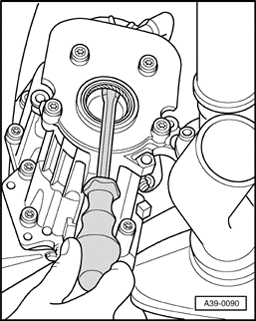Dynamism, sportiness and sophistication – the Audi A3 holds an outstanding position in the premium compact class. Now its top-of-the-range version is ready to go, the new Audi S3 boasting 195 kW (265 bhp) and quattro permanent four-wheel drive.
With its sparkling performance it pursues the ideal of pure driving pleasure coupled simultaneously with excellent everyday practicality – like all Audi S models.
The S3 redefines the standards of its class – at the level of a sports car. The sprint to 100 km/h is accomplished in 5.7 seconds, and acceleration is only halted on reaching 250 km/h. Aggressively hard-hitting, free-revving and with a sonorous acoustic profile, the powerful two-litre, turbocharged four-cylinder unit with FSI petrol direct injection proves to be a smooth, high-performance engine.
This power is transmitted by the six-speed gearbox and quattro permanent four-wheel drive to large alloy wheels with an 18-inch diameter. The new S sports suspension system on the S3 enables an extremely sporty driving style combined with the ultimate in comfort. This sporty compact model responds actively to steering movements, exhibits precise and safe handling characteristics and, thanks to quattro technology, enables maximum acceleration out of bends.
The dynamic potential of this three-door sports car is obvious at first glance. The single-frame grille sports chrome trim, the front skirt has a spoiler with large air-intakes and the side sills have been restyled. There is a contrasting platinum grey diffuser built into the rear skirt, along with two S-style oval chrome tailpipes. Aluminium-look door mirrors and a body-colour roof spoiler give added impact to the visual statement.
Interior: Sporty atmosphere
The interior conveys an atmosphere of sportiness, with materials of the highest quality and painstaking craftsmanship. The elements that dominate the styling are the sports seats with prominent side sections, the black headlining, also available in silver, and the instrument cluster with its special dials and needles.
The pedals, gear knob and air vents are in aluminium look, the inlays are in Piano finish black, or alternatively Aluminium or Fine grain birch wood grey. The red and silver S3 emblem is to be found on the leather sports steering wheel, in the instrument cluster, on the gear knob and on the door sill trims. The seats are upholstered in a combination of cloth and leather or, as an option, in Alcantara/leather or completely in leather. The two-tone leather seats are decorated with stitching in the same colour as their centre section.
TFSI in its most powerful form
The power plant of the S3 delivers all that is expected of a powerful sports engine, and does it supremely well. The 2.0 TFSI, which combines direct injection and turbocharger technology, delivers 195 kW (265 bhp) at 6,000 rpm. And at just 2,500 rpm it already musters up an impressive 350 Nm of torque – this pulling power remains constant up to 5,000 rpm. In the combined driving cycle the 2.0 TFSI displays another welcome character trait, consuming just
9.1 litres of fuel over 100 km – further proof of the forward-looking efficiency of TFSI technology developed by Audi.
Compared with the A3, this engine is an advanced version which has undergone fundamental changes. The new turbocharger with its enlarged turbine and compressor rotor generates 1.2 bar of boost pressure – an unusually high figure. A modified intercooler significantly lowers the temperature of the compressed air, thus increasing the air mass necessary for combustion.
Pistons with stronger pins and strengthened connecting rods with new bearings transmit the powerful forces to the crankshaft. The cylinder block has been stiffened up and the head is made of a new, highly heat-resistant alloy.
The exhaust camshaft timing has been adjusted to accommodate the increased power output. High-pressure injectors with an enlarged cross-section squirt the fuel straight into the combustion chamber.
Despite all this progressive engineering, the high-performance turbo weighs in at just 152 kilos, which is less than comparable power plants from direct competitors, and this has a positive effect on the axle load distribution. The compact dimensions of the 2.0 TFSI make it suitable for transverse installation, which brings benefits in terms of the S3’s interior space and luggage capacity.
To go with its sporty nature and firm handling, the new Audi S3 has a six-speed, close-ratio manual gearbox. Gearshift travel has been reduced for the S3, enabling even sportier and more precise gear changes. As is the case for all
Audi S models, the new S3 drives all four wheels by means of quattro permanent four-wheel drive. An electronically controlled multi-plate clutch, positioned at the rear for the benefit of weight balance, distributes the torque as needed – delivering plenty of grip and maximum driving safety. All the components in the drive train have been strengthened to cope with the high level of engine torque
Handling: Lightning-fast reactions
In terms of handling, the Audi S3 exhibits all the qualities of a high-performance sports car; it responds immediately to steering movements and achieves high cornering speeds. The innately sophisticated suspension of the
A3 – with subframes front and rear, triangulated lower wishbones at the front and four-link suspension at the rear – has been further refined.
Springs and shock absorbers are stiffer, and the body sits 25 mm lower than an A3 with standard suspension. Aluminium pivot bearings and wishbones reduce the weight of the front suspension. Stiffer suspension mounts and a sportier characteristic for the electro-mechanical steering convey even greater dynamism and precision. 18-inch alloy wheels and 225/40 tyres ensure firm adhesion to the road surface. A 17-inch brake system with sports brake pads ensure maximum deceleration; the black painted callipers bear S3 emblems.
The extras also include a leather steering wheel with flat-bottomed rim and – in the quattro GmbH range – folding bucket seats. In the infotainment area, Audi is presenting a new generation of audio systems. The premium package is rounded off by universal interfaces for mobile phone and iPod, plus a sound system from Bose. Standard equipment includes deluxe automatic air conditioning, a driver information system with a new lap-timer function, and an anti-theft alarm. Front fog lights and xenon plus headlights with daytime running lights underline the impressive price/performance ratio. The basic price of the 265 bhp Audi S3 in Germany is EUR 35,150.

